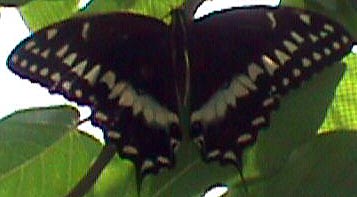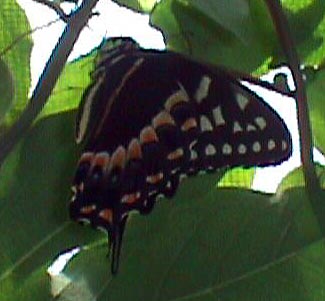PALAMEDES SWALLOWTAIL Papilio palamedes
 Palamedes is one of the most abundant
butterflies in my garden. They love my red Penta, and are one of the first
butterflies I see in spring. It's a large swallowtail, with a wing span of 4 1/2 - 5
1/8 inches, making it one of the largest butterflies in North America. It is a
black-brown butterfly with a broad yellow band on each hindwing. Its tails are
straight-sided and do not expand into a club shape, like those of the Giant or Black
Swallowtails. It also has a yellow stripe along the body. It is very abundant
in wet woods near rivers and broadleaf evergreen swamp forests.
Palamedes is one of the most abundant
butterflies in my garden. They love my red Penta, and are one of the first
butterflies I see in spring. It's a large swallowtail, with a wing span of 4 1/2 - 5
1/8 inches, making it one of the largest butterflies in North America. It is a
black-brown butterfly with a broad yellow band on each hindwing. Its tails are
straight-sided and do not expand into a club shape, like those of the Giant or Black
Swallowtails. It also has a yellow stripe along the body. It is very abundant
in wet woods near rivers and broadleaf evergreen swamp forests.
Eggs are yellowish-green. Host plants are members of the Laurel Lauraceae
Family, and include redbay Persea borbonia,  sweet bay trees Magnolia
virginiana, and sassafras Sassafras albidum. Caterpillars look
very much like bird droppings in it's early stages. Later stages are grass-green and
have large rimmed orange eyespots with black pupils on the thorax, and mimic a snake to
scare off predatory birds. They possibly overwinter as a caterpillar as well as a
chrysalis. Butterflies nectar on other plants beside the red Penta:
porterweed, sweet pepperbush, thistles, blue flag, and azalea. They'll also nectar
at pickeralweed, which grows in shady spots in swamps, and are reported to roost
communally in oaks and palmettos.
sweet bay trees Magnolia
virginiana, and sassafras Sassafras albidum. Caterpillars look
very much like bird droppings in it's early stages. Later stages are grass-green and
have large rimmed orange eyespots with black pupils on the thorax, and mimic a snake to
scare off predatory birds. They possibly overwinter as a caterpillar as well as a
chrysalis. Butterflies nectar on other plants beside the red Penta:
porterweed, sweet pepperbush, thistles, blue flag, and azalea. They'll also nectar
at pickeralweed, which grows in shady spots in swamps, and are reported to roost
communally in oaks and palmettos.
Palamedes have been wonderfully described as "the signature swallowtail of the
great [southeastern] swamps." It defiantly fits in my garden. I see them
every time I go out in the garden, nectaring along with the Monarchs, Gulf Fritillaries,
Sulphurs, Black Swallowtails, and Pipevine Swallowtails. Palamedes is always there.
They are closely related to the Spicebush Swallowtail (which I haven't seen).
Both have similar courtship flights. Sometimes the two species will court each
other.
 Back to the butterflies
Back to the butterflies
 Palamedes is one of the most abundant
butterflies in my garden. They love my red Penta, and are one of the first
butterflies I see in spring. It's a large swallowtail, with a wing span of 4 1/2 - 5
1/8 inches, making it one of the largest butterflies in North America. It is a
black-brown butterfly with a broad yellow band on each hindwing. Its tails are
straight-sided and do not expand into a club shape, like those of the Giant or Black
Swallowtails. It also has a yellow stripe along the body. It is very abundant
in wet woods near rivers and broadleaf evergreen swamp forests.
Palamedes is one of the most abundant
butterflies in my garden. They love my red Penta, and are one of the first
butterflies I see in spring. It's a large swallowtail, with a wing span of 4 1/2 - 5
1/8 inches, making it one of the largest butterflies in North America. It is a
black-brown butterfly with a broad yellow band on each hindwing. Its tails are
straight-sided and do not expand into a club shape, like those of the Giant or Black
Swallowtails. It also has a yellow stripe along the body. It is very abundant
in wet woods near rivers and broadleaf evergreen swamp forests.  sweet bay trees Magnolia
virginiana, and sassafras Sassafras albidum. Caterpillars look
very much like bird droppings in it's early stages. Later stages are grass-green and
have large rimmed orange eyespots with black pupils on the thorax, and mimic a snake to
scare off predatory birds. They possibly overwinter as a caterpillar as well as a
chrysalis. Butterflies nectar on other plants beside the red Penta:
porterweed, sweet pepperbush, thistles, blue flag, and azalea. They'll also nectar
at pickeralweed, which grows in shady spots in swamps, and are reported to roost
communally in oaks and palmettos.
sweet bay trees Magnolia
virginiana, and sassafras Sassafras albidum. Caterpillars look
very much like bird droppings in it's early stages. Later stages are grass-green and
have large rimmed orange eyespots with black pupils on the thorax, and mimic a snake to
scare off predatory birds. They possibly overwinter as a caterpillar as well as a
chrysalis. Butterflies nectar on other plants beside the red Penta:
porterweed, sweet pepperbush, thistles, blue flag, and azalea. They'll also nectar
at pickeralweed, which grows in shady spots in swamps, and are reported to roost
communally in oaks and palmettos.